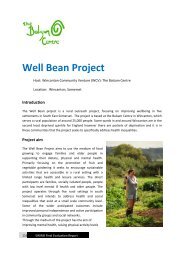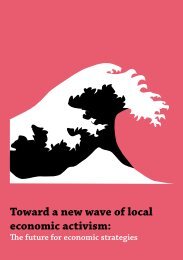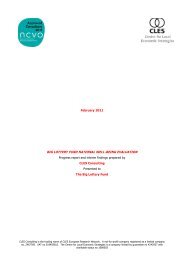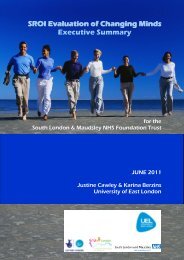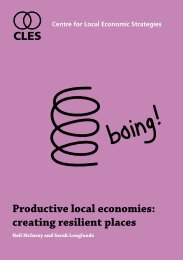Research Methods Handbook.pdf - CLES
Research Methods Handbook.pdf - CLES
Research Methods Handbook.pdf - CLES
Create successful ePaper yourself
Turn your PDF publications into a flip-book with our unique Google optimized e-Paper software.
QRPhenomenologyA research methodology which has its roots in philosophy and whichfocuses on the lived experience of individuals.PopulationSee research populationPositivismA paradigm that assumes human behaviour is determined by externalstimuli and that it is possible to use the principles and methodstraditionally employed by the natural scientist to observe and measuresocial phenomena.Predictive researchConcerned with identifying indicators of future behaviour or demandin a population on the basis of the current behaviour and demands of asample. Predictive techniques use a number of statistical approaches.Primary sourceA primary source is a document, speech, or other sort of evidence written,created or otherwise produced during the time under study.QualitativeConcerned with a quality of information, qualitative methods attemptto gain an understanding of the underlying reasons and motivationsfor actions and establish how people interpret their experiences andthe world around them. Qualitative methods provide insights into thesetting of a problem, generating ideas and/or hypotheses.QuantitativeAs the name suggests, is concerned with trying to quantify things; itasks questions such as ‘how long’ or ‘how many’. Quantitative methodslook to quantify data and generalise results from a sample of the populationof interest. They may look to measure the incidence of variousviews and opinions in a chosen sample, for example.Random sampleA sample of a population where each member of the population has anequal chance of being in the sample.RangeA measure of variability indicating the difference between the highestand lowest values in a distribution of scores.SRatio scaleRatio scales are like interval scales except they have a zero point. Agood example is height or temperature. These have a scale with anabsolute zero. Thus, a height of 2 metres is twice as high as a height of1 metre.ReferencesA reference is a formal system for drawing attention to a literaturesource, usually published, both in the report itself and in the bibliographyor reading list at the end of the report. There are two main methodsof referencing articles in journal and book publications. These areknown as the Harvard (author-date) and Vancouver (author-number)reference systems.RelevanceIs about the closeness with which the data being gathered feeds intothe aims of the study.ReliabilityThe extent to which the same result will be repeated/achieved by usingthe same measure.<strong>Research</strong> planThis is the researcher’s guidebook for the project, and the yardstickagainst which the various stages of progress can be judged. It states theoutputs to be delivered and the timescale.<strong>Research</strong> populationThe total number of potential subjects for your research.RespondentAn individual or organisation that responds to research questions.Response rateThe proportion of people asked to take part in research who actuallytake part.SamplingThe process by which you reduce the total research population for aresearch project to a number which is practically feasible and theoreticallyacceptable (the sample).Sampling: non randomNon random sampling means that the principle of randomness has notbeen maintained in the selection of a sample. Often it involves struc-68 69



